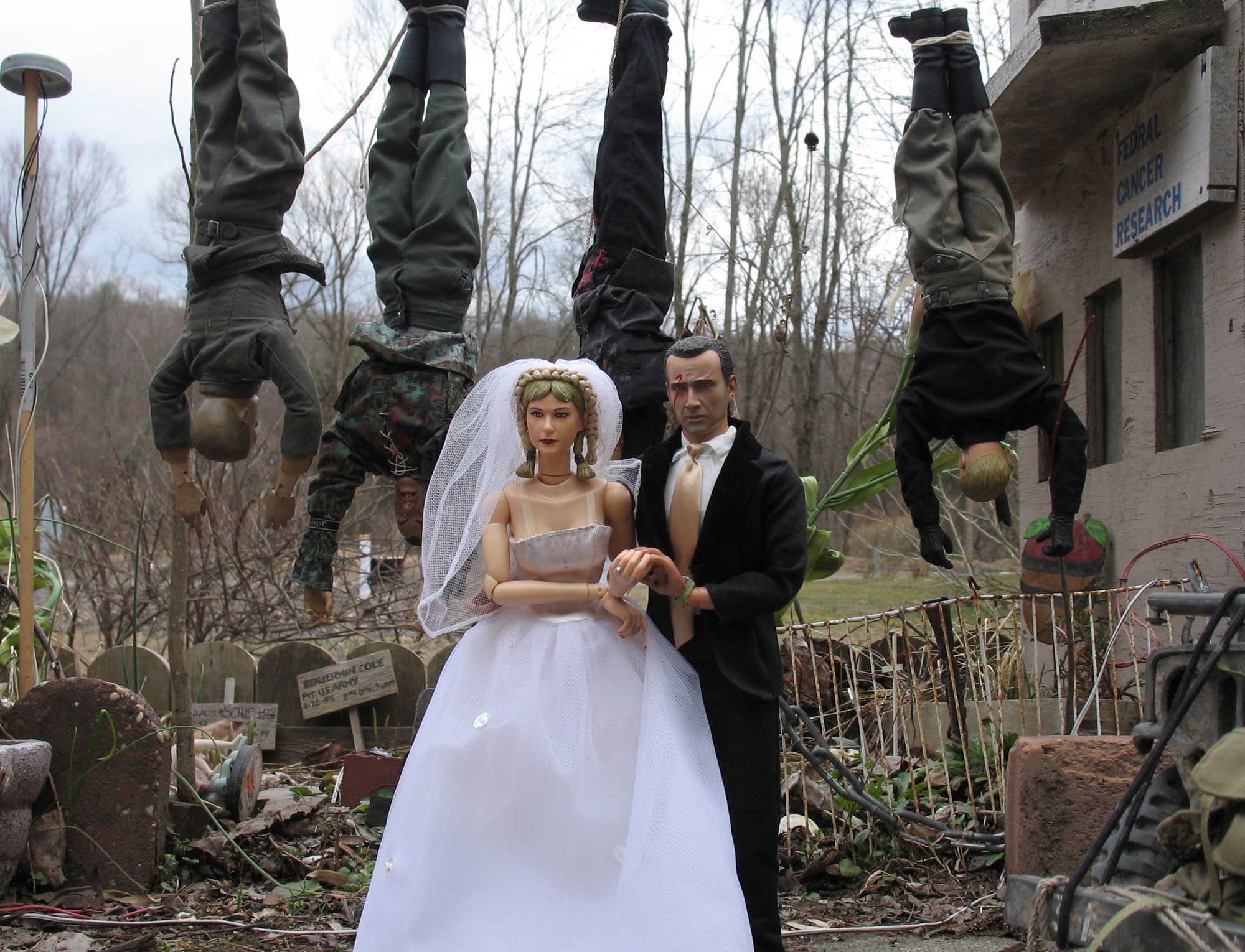Cool article on Mark Hogancamp in today’s NY Times. Hogancamp was the subject of the documentary Marwencol, which I posted about when I saw it a few months back. I can’t encourage you strongly enough to see this documentary, it’s one of the best films I’ve ever seen about the process of and the reasons for making art.
MARWENCOL: A GREAT FILM ABOUT STORYTELLING

a marriage in Marwencol
The big art documentary of 2010 is Banksy’s Exit Through the Gift Shop, a great film which my best friend told me he found profoundly reassuring and inspiring on a creative level. If this Mr. Brainwash guy, who overcomes apparent lack of actual artistic talent, can succeed through sheer force of will, then anyone can. I loved it too, but I found it profoundly depressing to watch the man mass-producing his artworks and corralling hype like a magician.
Last night, however, I saw Jeff Malmberg’s Marwencol, an extraordinary documentary about a man named Mark Hogancamp. This film was the one that affected and inspired me. It reminded me what a rich and complex experience it is to create a world.
Hogancamp is a man whose memory and motor skills were destroyed by a brutal assault that left him in a coma. Afterward, kicked out of the hospital and denied sufficient physical therapy because he had no insurance, he continued his therapy on his own, regaining his dexterity by building models. He built an entire WWII-era Belgian town called Marwencol in his backyard, and populated it with dolls who represent people in his life–people with whom he shared history he could no longer remember, so he created a new history–a lurid, sexy, illustrative history that indulges his fantasies.
Those fantasies include finding love (he was married once, before the attack, but he can’t remember anything about it, and he can’t remember the experience of sex at all, so he was psychologically a virgin when he emerged from his coma) and taking brutal revenge on the men who attacked him. The stories he tells with the Marwencol characters channel those fantasies in fascinating ways that sometimes affect his relationships with people in the real world. Have you ever written something based on a friend, had it published, then had the awkward experience of explaining this to that friend? Parts of Marwencol may seem familiar.
Hogancamp was profoundly damaged by his experience, and if you met him without knowing anything about his past or about the complexity and detail of the world he created–that is, if he just started introducing you to his dolls–you’d think he was unhinged. But I challenge anyone who’s ever experienced creative euphoria–flow–while constructing a narrative to watch Marwencol and not recognize the immersive quality of his invented world and the emotional investment he makes in it. It is a reminder of how transformative, how elevating, the process of creation can be, and how it can have the vertiginous effect of making your life feel like it’s worth more than it was the day before. (Vertiginous because on unproductive days, you feel the decline in value, too.)
I’d say more but the film is best appreciated without too much preamble, and the point of posting this is not to analyze it but to say go see it, if at all possible. Marwencol is maybe the best film I’ve ever seen about the reasons for making art.
Second Mess Section

1. After being beaten into a brain-damaging coma by five men outside a bar, Mark built a 1/6th scale World War II-era town in his backyard. –Marwencol, a photoblog
2. ‘And I personally only like high-class escorts. I don’t like sleeping with people I really love. I don’t want to sleep with them because sex cannot last, but affection can last forever. I think this is healthy. And for the way the rich live, this is possible. But the other world, I think they need porn. I also think it’s much more difficult to perform in porn than to fake some emotion on the face as an actor.’ –an interview with Karl Lagerfeld
3. Kubrick triple shot: Johannes Goransson & Joyelle McSweeney on The Shining, NotComing.com on The Shining (Kubrick: Freud in his essay on the uncanny wrote that the sense of the uncanny is the only emotion which is more powerfully expressed in art than in life, which I found very illuminating; it didn’t help writing the screenplay, but I think it’s an interesting insight into the genre.), and NotComing.com on my favorite enigma: Eyes Wide Shut.
4. ‘It turns out the doppleganger is Anya Liftig, a Brooklyn-based performance artist, and her intervention on Abramovic’s “The Artist is Present” was a performance of her own, which she has titled “The Anxiety of Influence” after the Harold Bloom book of the same title.’ –an interview with said interloper
